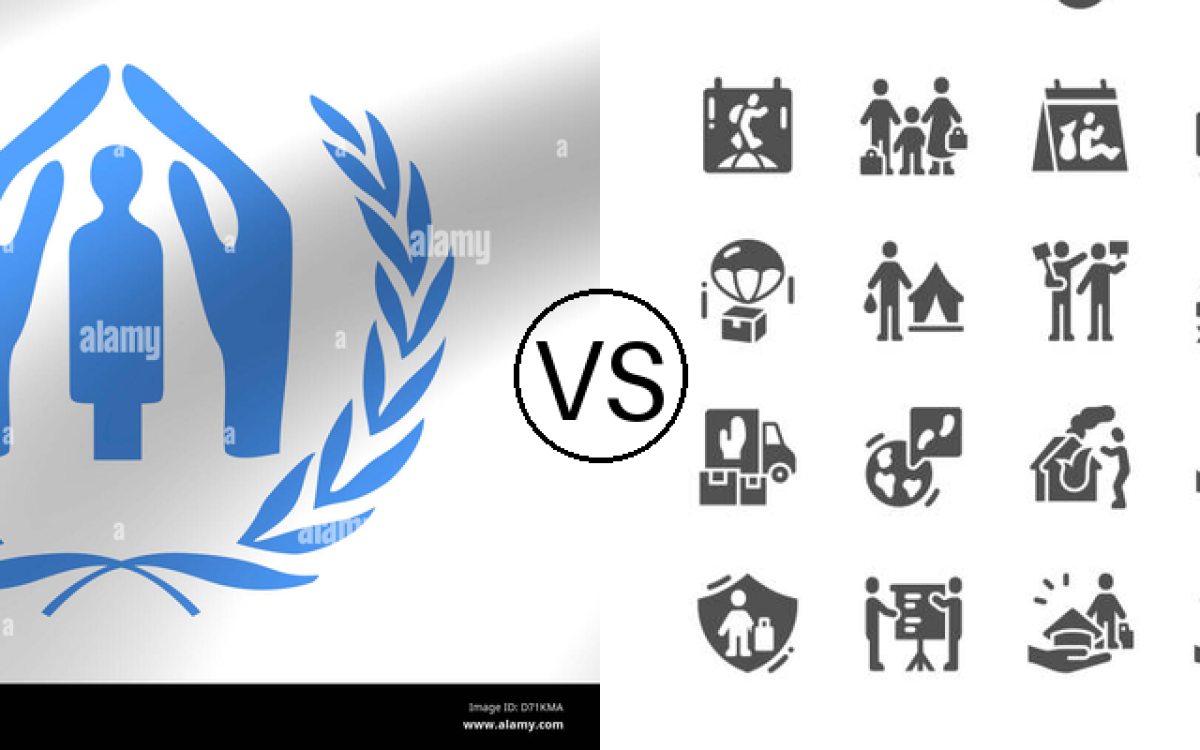Image Source: AI GeneratedThe world faces an unprecedented crisis. 120 million people across the globe have left their homes behind – a number that has doubled in just a decade. People often mix up the terms refugee and asylum seeker, but these words mean different things in humanitarian protection systems.
The numbers tell a striking story. From these displaced people, 43 million hold refugee status, while 6.9 million are registered asylum seekers. The United States and Germany receive the most asylum applications, especially when you have nationals coming from Venezuela, Colombia, Syria, Sudan, and Afghanistan. These individuals’ protection comes from the 1951 Refugee Convention through international law, though their rights and processes vary based on their status.
Let’s look at what makes refugees different from asylum seekers – from legal definitions to protection rights. This piece will help you understand these vital differences, whether you want to learn about humanitarian systems or global migration patterns.
Refugee vs Asylum Seeker: Legal Definitions Explained
Legal definitions are the foundations of understanding the difference between refugees and asylum seekers. These terms have specific meanings under international law that determine protection rights and entitlements.
What is a refugee according to international law?
The 1951 Convention Relating to the Status of Refugees defines a refugee as someone who, “owing to well-founded fear of being persecuted for reasons of race, religion, nationality, membership of a particular social group or political opinion, is outside the country of [their] nationality and is unable or, owing to such fear, is unwilling to avail [themself] of the protection of that country”. A person becomes a refugee as soon as they meet these criteria, even before receiving official recognition.
Asylum seeker vs refugee: Key legal distinctions
An asylum seeker has left their country to seek protection from persecution and serious human rights violations in another country, but hasn’t received legal recognition as a refugee yet. Every refugee started as an asylum seeker, but not all asylum seekers ended up becoming refugees. It’s worth mentioning that seeking asylum is a fundamental human right.
The role of the 1951 Refugee Convention
The 1951 Refugee Convention and its 1967 Protocol serve as the legal foundation for refugee protection worldwide. Refugees enjoy specific rights under this framework:
- Protection from being returned to dangerous situations (non-refoulement)
- Freedom from punishment for irregular entry
- Right to access housing, education, and work
- Freedom of movement within host countries
States must cooperate with UNHCR to protect these rights.
Migrants vs refugees: Understanding the terminology
Migrants differ from refugees and asylum seekers because they choose to move without facing direct threats or persecution. They mainly seek better lives through work, education, or family reunification. Difficult circumstances like food insecurity or economic collapse can drive migration, but migrants generally keep their home country’s protection. Regional legal instruments in Africa and Latin America have broadened the refugee definition to include people fleeing generalized violence or events that seriously disturb public order.
The Application Process: From Asylum Seeker to Refugee
The trip from asylum seeker to refugee status requires you to deal with complex paperwork. These processes look different based on where you are in the world. Anyone seeking international protection needs to know these procedures well.
How asylum applications work worldwide
Asylum applications follow two main paths around the world. Countries with 15-year old asylum systems let people apply directly to their national authorities. Other nations without formal procedures rely on the United Nations High Commissioner for Refugees (UNHCR) to determine refugee status. Right now, UNHCR handles this task in about 50 countries. The key difference is that asylum seekers must be physically in the country where they want protection. This differs from refugee applications that can start from anywhere.
Refugee status determination process
Refugee Status Determination (RSD) helps officials decide if someone qualifies as a refugee under international law. The assessment looks at whether applicants:
- Meet the refugee definition
- Have not settled permanently in another country
- Can be admitted under current laws
Officials look at all available evidence carefully, including personal stories and conditions in the home country. To cite an instance, specially-trained USCIS officers in the United States conduct friendly interviews to assess eligibility.
Documentation requirements for asylum seekers
Asylum applications need many documents. Form I-589 serves as the starting point in the US system. People seeking asylum must also show proof of their claims about persecution through:
- Identity documents
- Evidence of nationality
- Records of past persecution
- Proof they belong to targeted groups
Average processing times by country
Different countries take varying amounts of time to process cases. Luxembourg’s average asylum procedures went from 7 months in 2018 to 10 months in 2022. The US system faces bigger challenges with a backlog of more than two million cases. This means people wait up to seven years for answers. Dutch applicants wait over a year on average for decisions. These long waiting periods affect families deeply and slow down their ability to start new lives.
Protection Rights: What Each Status Provides
Protection rights create big practical differences between refugees and asylum seekers in their daily lives. These differences affect everything from employment to family unity and create very different life experiences.
Legal protections for recognized refugees
Recognized refugees receive complete protections under the 1951 Convention. They are protected from forced return to danger and cannot be punished for irregular entry. They also have access to courts. Refugees have the right to decent work, housing, education, freedom of religion, and social protection. Their rights never expire since refugee status remains valid indefinitely.
Temporary protections for asylum seeker
Asylum seekers get limited protections while they wait for decisions. The United States may grant Temporary Protected Status (TPS) to people from certain countries when conditions make it unsafe to return. TPS remains temporary and doesn’t lead to permanent residency. Asylum seekers should not face detention just for irregular entry, yet many do.
Work authorization differences between refugees and asylum seekers
The employment situation differs dramatically between these statuses. Refugees can work indefinitely as soon as they get their status. Asylum seekers face many restrictions. US law requires asylum applicants to wait 180 days after filing before they can ask for work authorization. This waiting period makes it hard to be self-sufficient. They have limited access to housing help, food stamps, or financial support during this time.
Family reunification rights comparison
Family reunification works differently for each group. Refugees can petition for spouses and unmarried children under 21 through the I-730 process. They must file this petition within two years of arrival or asylum grant. The P-3 category of the US Refugee Admissions Program lets them file an Affidavit of Relationship (AOR) within five years of arrival. Both processes usually take years to complete. This creates long family separations even with legal ways to reunite.
Global Refugee Crisis: Statistics and Trends
Global displacement has reached unprecedented levels. Recent statistics paint a stark picture of the refugee and asylum seeker crisis worldwide.
Current refugee and asylum seeker populations
The world now has 122.6 million people who have been forcibly displaced. This number includes 43.7 million refugees and about 8 million asylum seekers. Refugee numbers have more than tripled in the last decade. Children make up 40% of all forcibly displaced people worldwide. This shows how the crisis affects the most vulnerable groups.
Top countries of origin for asylum seekers
Syria and Afghanistan stand as the main sources of refugees worldwide. Each country has 6.4 million displaced people. These two nations account for one-third of all refugees under UNHCR’s mandate. Venezuela follows with 6.1 million refugees and people who need protection. Ukraine has 6 million refugees. Sudan has become the newest major crisis point with more than 2 million refugees and about 9.1 million internally displaced people.
Major host countries for refugees
Turkey leads the world in hosting refugees with about 3.6 million, mostly from Syria. Pakistan and Iran serve as main hosts for Afghan refugees. Iran houses 3.4 million while Pakistan shelters 1.7 million. Low and middle-income countries host 75% of all refugees. This fact challenges the belief that wealthy nations carry the heaviest burden. Most displaced people stay close to home, with 69% living in neighboring countries.
Approval rates for asylum applications
Recognition rates show big differences based on nationality. The first half of 2024 saw an overall approval rate of 46% – the highest since 2016. Belarusians and Afghans now have some of the highest approval rates at 88.4%. Asylum seekers from the Dominican Republic face the lowest rates at just 11%. Ukrainian recognition rates show dramatic changes. They rose from 12% in 2021 to 91% in 2023, reflecting the changing political landscape.
Comparison Table
| Aspect | Refugee | Asylum Seeker |
|---|---|---|
| Legal Definition | Person who meets criteria under 1951 Convention: has well-founded fear of persecution due to race, religion, nationality, social group, or political opinion | Person who has left their country seeking protection but hasn’t yet been legally recognized as a refugee |
| Legal Status | Officially recognized and protected under international law | Temporary status while awaiting refugee status determination |
| Work Authorization | Authorized to work indefinitely, employment eligible based on status | Must wait at least 180 days after filing before applying for work authorization (US) |
| Protection Rights | Detailed protections including non-refoulement, freedom from punishment for irregular entry, access to courts, housing, education | Limited protections while awaiting decision; may receive Temporary Protected Status (TPS) in some cases |
| Family Reunification | Can petition for spouses and unmarried children under 21; has access to P-3 category of US Refugee Admissions Program | Not mentioned in this piece |
| Application Process | Can be initiated from outside the country | Must be physically present within the country where seeking protection |
| Processing Time | Not mentioned | Varies by country: 10 months (Luxembourg), up to 7 years (US), over 1 year (Netherlands) |
| Global Population | 43.7 million | 8 million |
Conclusion
The differences between refugees and asylum seekers matter more than ever as global displacement reaches record levels. These groups flee persecution but face different legal statuses, rights, and experiences during their path to safety.
Current numbers tell a stark story – 122.6 million forcibly displaced people worldwide, with 43.7 million refugees and 8 million asylum seekers. Behind these figures are real people who wait long periods, struggle with limited work rights, and face complex paperwork before they gain permanent protection.
The 1951 Refugee Convention offers vital safeguards, but countries implement these rules differently. Refugees receive detailed protections and work rights. Asylum seekers must direct through restricted job access and limited social services. Their cases often take months or years to resolve.
Developing nations shoulder most of the responsibility, with 75% of refugees living in low and middle-income countries. This fact challenges popular beliefs about refugee distribution and shows why we need better international teamwork.
The world faces growing pressure to solve these humanitarian challenges. Changes in acceptance rates, processing times, and protection standards affect millions caught between danger and safety. Understanding how refugee and asylum seeker status differs helps shape better responses to forced displacement across the globe.








2 Comments
Vel aliquam cumque repudiandae. Illo itaque dolores ab sapiente. deserunt maxime perferendis rerum voluptatibus aut. Ab et molestiae labore repellat. Ut cupiditate reiciendis veniam enim voluptatem cum. ullam et dolores omnis blanditiis rerum Culpa nisi illo eum. perferendis odio aut. Quia sit sit repellat vel tenetur. Aut
Perspiciatis est facilis neque. Perspiciatis eveniet necessitatibus voluptatem sed sed id asperiores. Voluptatem numquam dolorem minus nam. Similique velit praesentium inventore iure facilis et voluptas. Maiores ut aperiam fugit recusandae numquam sit. Magnam voluptatem est ipsum dolores sit pariatur. Possimus nostrum corporis aspernatur ipsum et alias. Rerum dolorem perspiciatis corrupti. Et enim repudiandae et sit voluptatibus magni pariatur et. Dolor hic quis voluptatem est qui consequatur. Qui officia illum sint est aliquid labore animi ut.